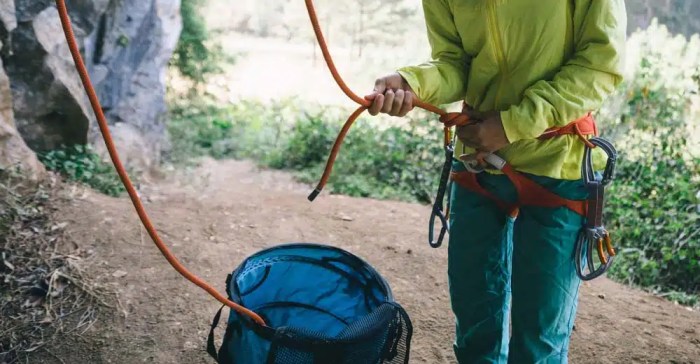Ever dreamt of conquering towering cliffs and reaching new heights? Whether you’re a seasoned climber or just starting out, mastering essential climbing knots is the key to a safe and enjoyable adventure. Think of knots as your climbing BFFs, the ones who keep you securely attached to the rock and help you navigate the vertical world.
This guide is your ultimate toolkit for unlocking the secrets of climbing knots. We’ll break down the 25 most useful knots, from the basics to some more advanced techniques, and show you how to tie them like a pro.
Get ready to level up your climbing game and conquer any peak you set your sights on!
Introduction to Climbing Knots
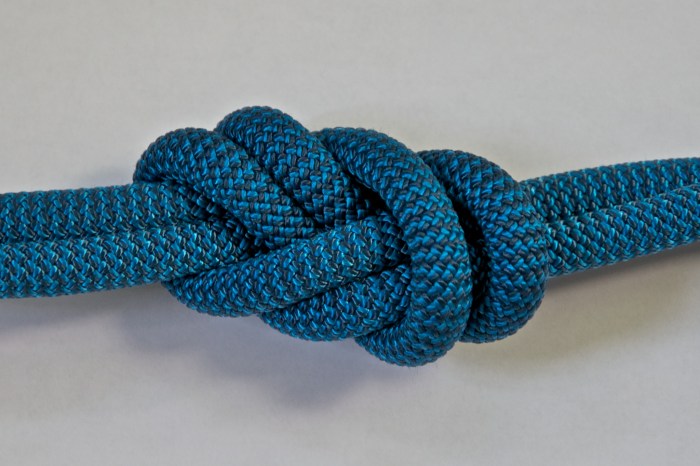
Climbing knots are the unsung heroes of the climbing world. They’re the glue that holds everything together, ensuring your safety and allowing you to conquer new heights. Think of them as the secret weapon in your climbing arsenal, providing the crucial link between you and the mountain.Learning essential climbing knots isn’t just about knowing how to tie them; it’s about understanding their purpose and how to use them effectively.
It’s like learning the alphabet of climbing, where each knot has a specific role to play in making your climb successful and safe.
Importance of Knots in Climbing
Knots are essential for climbers because they provide a secure connection between ropes, anchors, and other equipment. They are the backbone of climbing safety, acting as a fail-safe mechanism to prevent falls and ensure a secure connection.
Benefits of Learning Essential Climbing Knots
Learning essential climbing knots offers a variety of benefits:
- Safety First:Knots are crucial for ensuring a secure connection to the rope, preventing falls and accidents.
- Confidence Booster:Mastering basic knots builds confidence in your ability to handle equipment and navigate different climbing situations.
- Versatility:Knowing various knots allows you to adapt to different climbing situations and use the most suitable knot for each scenario.
- Problem-Solving:Understanding knots gives you the knowledge to create secure anchors and overcome unexpected challenges.
Choosing the Right Knot
Choosing the right knot for a specific climbing situation is essential for safety and efficiency. Consider these factors:
- Purpose:Determine the specific function of the knot. Do you need a knot for tying into a rope, creating an anchor, or securing a load?
- Rope Type:Different rope types may require specific knots. For example, static ropes are often used for anchoring, while dynamic ropes are used for climbing.
- Environment:The climbing environment can influence knot selection. For example, a knot used for ice climbing may differ from one used for rock climbing.
- Experience Level:Beginners should start with simple, reliable knots and gradually progress to more complex knots as their experience grows.
Essential Climbing Knots
You’ve mastered the basics of knots, and now it’s time to level up your climbing game with the essential knots that every climber should know. These knots are your trusty sidekicks, keeping you safe and secure on the wall.
Anchoring Knots
Anchoring knots are the foundation of your climbing safety, securing you to the rock, and ensuring you have a solid point to clip your rope.
Learning to tie climbing knots is like learning guitar scales – it’s all about mastering the fundamentals. Once you’ve got those down, you can start exploring the more advanced stuff, like the different types of knots and how to use them in different situations.
And just like learning to solo on the guitar, mastering climbing knots takes practice and dedication. If you’re looking to take your guitar skills to the next level, check out this awesome resource on pentatonic scales and modal solos: Guitar Soloing From Pentatonic Scales to Modes Use Major & Minor Pentatonic Scales to Play Exciting Modal Solos (Learn Guitar Theory and Technique).
But back to climbing knots, once you’ve got the basics down, you’ll be ready to tackle any climb!
-
Figure-Eight Knot
The Figure-Eight is a classic and reliable knot, known for its simplicity and strength. It’s your go-to knot for creating a secure loop at the end of your rope, preventing the rope from slipping through your belay device.
-
Figure-Eight on a Bight
Think of the Figure-Eight on a Bight as a Figure-Eight with an extra loop. It’s a versatile knot used for creating a secure anchor point on a single strand of rope.
-
Double Fisherman’s Knot
The Double Fisherman’s Knot is a powerful knot used to create a secure loop on a single strand of rope. It’s ideal for creating a strong anchor point on a single rope.
-
Bowline Knot
The Bowline is a legendary knot known for its ability to create a fixed loop at the end of a rope. It’s a crucial knot for creating a secure anchor point on a single strand of rope.
-
Triple Knot
The Triple Knot is a simple and effective knot for creating a secure loop on a single strand of rope. It’s used to secure a rope to a fixed point, such as a tree or a rock.
-
Alpine Butterfly Knot
The Alpine Butterfly is a versatile knot used for creating a secure anchor point on a single strand of rope. It’s known for its strength and ease of tying.
Belaying Knots
Belaying knots are the lifeline of your climbing experience, keeping you safe and secure as you ascend. These knots connect your rope to your belay device, ensuring a smooth and controlled descent.
-
Figure-Eight Knot
The Figure-Eight is a classic and reliable knot, known for its simplicity and strength. It’s your go-to knot for creating a secure loop at the end of your rope, preventing the rope from slipping through your belay device.
-
Munter Hitch
The Munter Hitch is a versatile knot used for belaying and rappelling. It’s a simple knot that can be tied quickly and easily.
-
Italian Hitch
The Italian Hitch is a powerful knot used for belaying and rappelling. It’s known for its ease of use and ability to be tied quickly.
-
French Prusik Knot
The French Prusik is a simple knot used for creating a friction hitch on a rope. It’s used for ascending ropes and for creating a backup belay system.
-
Autoblock Knot
The Autoblock is a simple and effective knot used for creating a friction hitch on a rope. It’s used for ascending ropes and for creating a backup belay system.
Rappelling Knots
Rappelling knots are your descent partners, allowing you to safely navigate down the wall. These knots ensure a smooth and controlled descent, keeping you secure as you make your way back to the ground.
-
Figure-Eight Knot
The Figure-Eight is a classic and reliable knot, known for its simplicity and strength. It’s your go-to knot for creating a secure loop at the end of your rope, preventing the rope from slipping through your belay device.
-
Munter Hitch
The Munter Hitch is a versatile knot used for belaying and rappelling. It’s a simple knot that can be tied quickly and easily.
-
Italian Hitch
The Italian Hitch is a powerful knot used for belaying and rappelling. It’s known for its ease of use and ability to be tied quickly.
Connecting Knots
Connecting knots are the connectors of the climbing world, allowing you to join ropes together or to attach your gear. These knots are the backbone of your climbing setup, ensuring a secure and reliable connection.
-
Figure-Eight Follow-Through Knot
The Figure-Eight Follow-Through is a strong and reliable knot used for joining two ropes together. It’s a simple knot that can be tied quickly and easily.
-
Double Fisherman’s Knot
The Double Fisherman’s Knot is a powerful knot used to create a secure loop on a single strand of rope. It’s ideal for creating a strong anchor point on a single rope.
-
Water Knot
The Water Knot is a simple and effective knot used for joining two ropes together. It’s used for creating a secure connection between two ropes.
-
Barrel Knot
The Barrel Knot is a strong and reliable knot used for joining two ropes together. It’s used for creating a secure connection between two ropes.
Advanced Knot Techniques
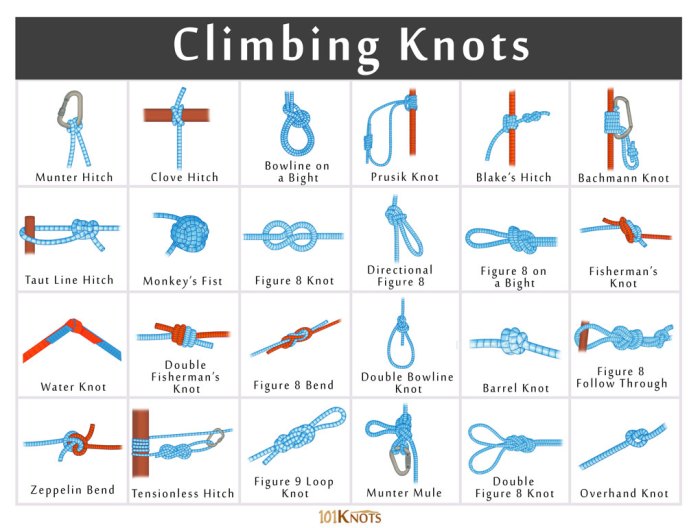
You’ve mastered the basics, but climbing is all about pushing your limits. Let’s level up your knot game with some advanced techniques that’ll have you tackling even the gnarliest climbs with confidence.
Tying Knots Under Pressure
Tying knots under pressure can be a real challenge, especially when adrenaline is pumping. But fear not, with practice and these tips, you’ll be tying knots like a pro, even in the most intense situations.
- Practice, Practice, Practice:The key to tying knots under pressure is to have them down cold. Practice tying your favorite knots over and over again until you can do it blindfolded. You can even practice tying knots while holding your breath to simulate the feeling of being under pressure.
The more you practice, the more confident you’ll be when it really counts.
- Stay Calm and Focused:When you’re under pressure, it’s easy to panic and make mistakes. Take a deep breath, slow down, and focus on each step of the knot-tying process. Don’t rush it. Remember, a well-tied knot is the difference between a successful climb and a nasty fall.
- Use a Knot Tying Aid:There are a variety of knot tying aids available that can help you tie knots more quickly and easily, especially under pressure. These aids can be particularly helpful when you’re wearing gloves or your hands are cold. Check out your local climbing shop for a variety of options.
Knot Combinations
Combining different knots can create a more secure and versatile system. Think of it as building a stronger rope by combining the strengths of different knots.
- The Double Fisherman’s Knot:This combination knot is super strong and secure, and is often used for attaching a rope to a harness or anchor. To tie a Double Fisherman’s Knot, you simply tie two Fisherman’s Knots together. This creates a double-layered knot that is less likely to slip.
So, you’re thinking about getting into climbing? Awesome! You’re gonna need to learn some knots, and “Climbing Knots for Beginners An Illustrated Guide to Tying the 25 Most Useful Climbing Knots” is the perfect place to start. But, hey, maybe you need a little more excitement in your life.
If you’re looking for a story with a bit of magic and romance, check out My Fated Protector A Grumpy Sunshine Paranormal Academy Romance. After that, you’ll be ready to tackle those knots and conquer any climbing challenge, whether it’s a real mountain or just the metaphorical one in your own life!
- The Figure Eight on a Bight with a Munter Hitch:This is a classic combination knot used for belaying and rappelling. The Figure Eight on a Bight provides a secure anchor point, while the Munter Hitch acts as a friction device to control the rope. This combination is versatile and reliable, making it a popular choice among climbers.
Troubleshooting Knot Issues
Even the best climbers make mistakes. But knowing how to identify and fix knot issues can save you from a serious fall.
- Inspect Your Knots Regularly:Before every climb, carefully inspect your knots for any signs of wear or damage. Look for frayed ropes, loose strands, or any other signs that the knot may be compromised. If you see any problems, re-tie the knot immediately.
- Know Your Knots:Be familiar with the different types of knots and their strengths and weaknesses. This will help you identify any problems with your knots and take appropriate action. For example, if you’re using a Figure Eight Knot for belaying, you should know that it can be prone to slipping if it’s not tied correctly.
So, you’re thinking about conquering the great outdoors with some serious climbing skills? “Climbing Knots for Beginners An Illustrated Guide to Tying the 25 Most Useful Climbing Knots” will be your best friend, but hey, maybe you need a little break from all that rope work and want to unleash your inner artist.
Check out Plānts Vs Zōmbiês Coloring Book 100 PAGES (2022 Edition) Deluxe Plānts Vs Zōmbiês Coloring Book For Children Ages 4-8 Ages 8-12 and Adults With High Quality Coloring Pages for a fun and relaxing way to de-stress after mastering those climbing knots! Once you’re back to conquering those peaks, you’ll be ready to take on any challenge.
- Don’t Be Afraid to Untie and Re-tie:If you’re not sure about a knot, it’s always better to untie it and re-tie it correctly. It’s better to be safe than sorry.
Practicing Advanced Knot Techniques
Mastering advanced knot techniques takes time and practice. Here are a few tips for honing your skills.
- Practice in a Safe Environment:When you’re first learning advanced knot techniques, it’s important to practice in a safe environment, such as a climbing gym or a backyard. This will allow you to make mistakes without putting yourself at risk.
- Use a Rope Trainer:A rope trainer is a great tool for practicing knots without having to climb. It allows you to simulate different climbing scenarios and practice tying knots under pressure.
- Get Feedback from Experienced Climbers:If you’re having trouble with a particular knot, ask an experienced climber for help. They can give you valuable feedback and tips for improving your technique.
Applying Advanced Knot Techniques in Climbing Scenarios
Advanced knot techniques can be applied in a variety of climbing scenarios, from setting up anchors to rappelling. Here are a few examples.
Yo, wanna get your climb on but feel like a total noob when it comes to knots? Don’t worry, “Climbing Knots for Beginners: An Illustrated Guide to Tying the 25 Most Useful Climbing Knots” is here to save the day.
Download And Listen Here and get ready to conquer those peaks, bro. This guide breaks down the essential knots in a way that’s super easy to understand, even if you’re a total beginner. So ditch the fear of falling and get your knot-tying skills on point.
- Setting Up Anchors:When setting up anchors, you can use a combination of knots to create a secure and redundant system. For example, you could use a Figure Eight on a Bight with a Munter Hitch to create a belay anchor.
You could also use a Double Fisherman’s Knot to attach your rope to the anchor.
- Rappelling:Rappelling requires a strong and reliable knot that can withstand the weight of your body. A Figure Eight on a Bight with a Munter Hitch is a popular choice for rappelling, as it provides a secure anchor point and allows you to control your descent.
- Rescue Situations:In rescue situations, advanced knot techniques can be used to create a variety of rescue systems. For example, you could use a Prusik Knot to ascend a rope, or a Munter Hitch to lower a climber who is injured.
Book Review
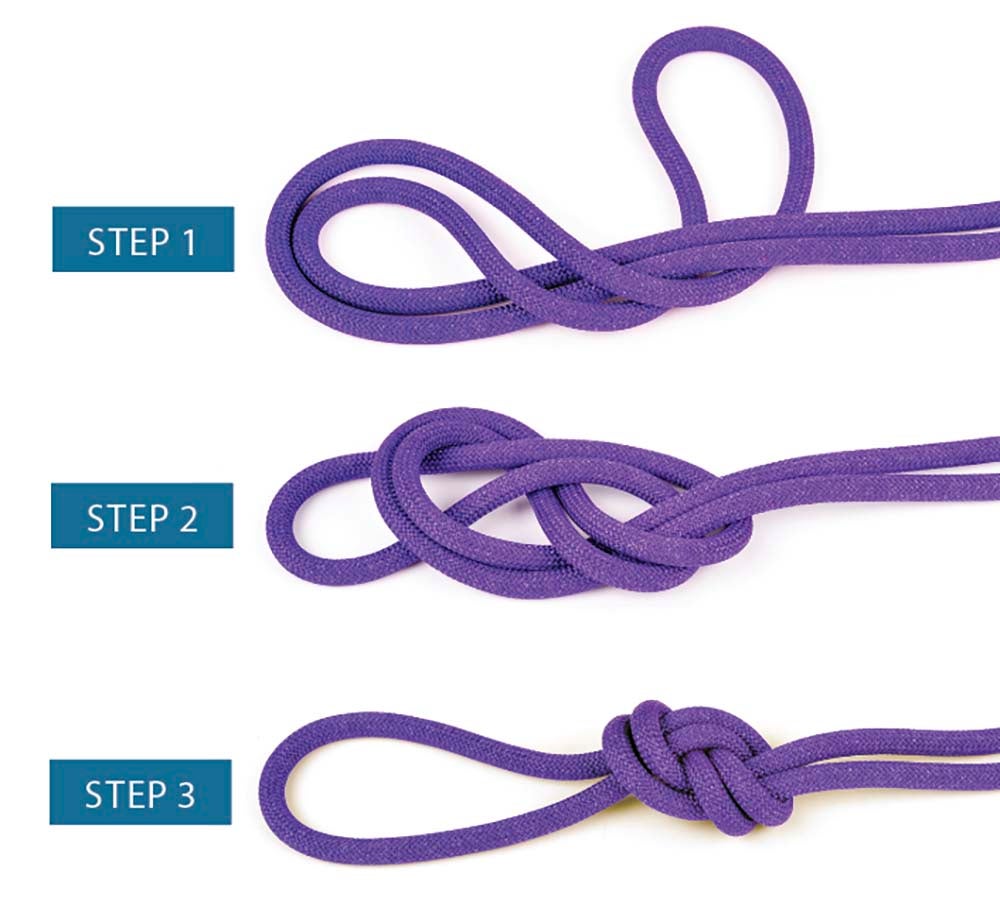
“Climbing Knots for Beginners: An Illustrated Guide to Tying the 25 Most Useful Climbing Knots” is a straightforward and practical guide for climbers of all levels. The book’s focus on essential knots, combined with its clear illustrations and step-by-step instructions, makes it a valuable resource for anyone looking to improve their knot-tying skills.
Strengths and Weaknesses
The book’s greatest strength lies in its simplicity and clarity. The author presents each knot in a concise and easy-to-follow manner, using detailed illustrations and step-by-step instructions. This approach makes the book accessible to beginners who may be intimidated by the complexity of knot-tying.
The book also includes a helpful section on troubleshooting common knot-tying errors, which can be invaluable for beginners who are just starting to learn. One potential weakness of the book is its limited scope. While it covers 25 essential knots, there are many other knots that climbers might find useful.
However, for beginners, the focus on the most essential knots is a good starting point. The book also lacks information on the history and etymology of the knots, which might be interesting to some readers.
Comparison to Other Resources
“Climbing Knots for Beginners” compares favorably to other popular climbing knot resources, such as “The Knot Book” by Ashley and “The Complete Knot Book” by Des Pawson. While these books offer a more comprehensive overview of knots, they can be overwhelming for beginners.
“Climbing Knots for Beginners” provides a more focused and accessible approach, making it an ideal starting point for those new to knot-tying.
Target Audience
The book is clearly aimed at beginner climbers, and it effectively caters to this audience. The language is simple and straightforward, and the illustrations are clear and easy to understand. The book’s focus on the 25 most useful climbing knots is also appropriate for beginners, as it provides a solid foundation in the essential knots they will need to know.
Last Recap
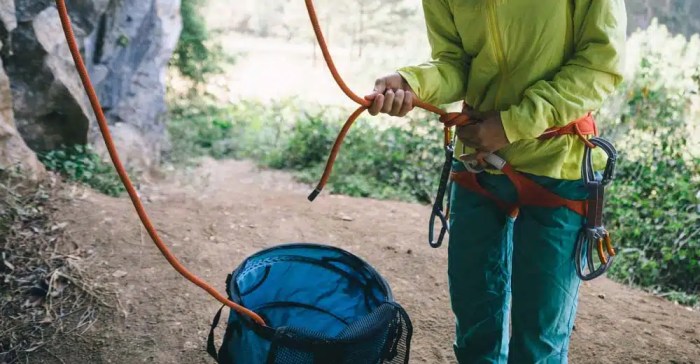
So, there you have it! You’ve learned the 25 most essential climbing knots, and now you’re ready to take your climbing to the next level. Remember, practice makes perfect, so get out there, tie those knots, and climb with confidence.
And hey, if you ever get stuck, just revisit this guide and remember, with the right knots, you’re always in good hands.
Questions and Answers
What if I forget how to tie a knot while climbing?
Always practice tying your knots before you head out. If you forget, it’s best to find a safe place to review your knots or consult a more experienced climber.
What are some common mistakes climbers make with knots?
Common mistakes include not tying knots tightly enough, not using the correct number of wraps, or not checking your knots after they’re tied. Always double-check your knots and make sure they are secure.
Do I need to learn all 25 knots right away?
Start with the basics and learn the knots you need for your current climbing style. As you progress, you can expand your repertoire.
How do I know if a knot is tied correctly?
Make sure the knot is tight and secure. You should be able to pull on the knot without it coming undone. If you have any doubts, it’s always best to retie the knot.

